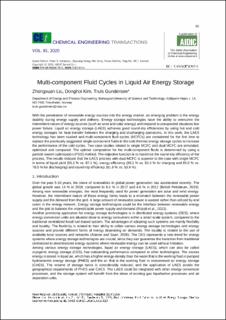Multi-component Fluid Cycles in Liquid Air Energy Storage
Peer reviewed, Journal article
Published version

Åpne
Permanent lenke
https://hdl.handle.net/11250/2734761Utgivelsesdato
2020Metadata
Vis full innførselSamlinger
Originalversjon
Chemical Engineering Transactions. 2020, 81 55-60. http://dx.doi.org/10.3303/CET2081010Sammendrag
With the penetration of renewable energy sources into the energy market, an emerging problem is the energy stability during energy supply and delivery. Energy storage technologies have the ability to overcome the intermittent nature of energy sources (such as wind and solar energy) and respond to unexpected situations like power failure. Liquid air energy storage (LAES) achieves good round-trip efficiencies by using hot and cold energy storages for heat transfer between the charging and discharging operations. In this work, the LAES technology has been studied and multi-component fluid cycles (MCFCs) are considered for the first time to replace the previously suggested single-component fluids in the cold thermal energy storage cycles to increase the performance of the cold cycles. Two case studies related to single MCFC and dual MCFC are simulated, optimized and compared. The optimal composition for the multi-component fluids is determined by using a particle swarm optimization (PSO) method. The objective function is to maximize the round-trip efficiency of the process. The results indicate that the LAES process with dual MCFC is superior to the case with single MCFC in terms of liquid yield (95.1 % vs. 87.1 %), exergy efficiency (86.1 % vs. 82.4 % for charging and 85.5 % vs. 78.5 % for discharging) and round-trip efficiency (61.8 % vs. 53.9 %).